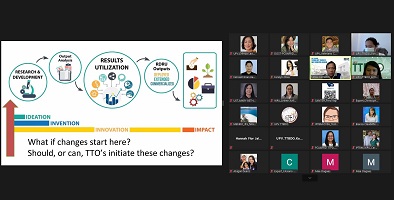 The patent mining program for selected commodities to influence changes in research and development (R&D) as well as technology transfer prioritization in the agriculture, aquatic, and natural resources (AANR) sector was rolled out by the Philippine Council for Agriculture, Aquatic and Natural Resources Research and Development of the Department of Science and Technology (DOST-PCAARRD).
The patent mining program for selected commodities to influence changes in research and development (R&D) as well as technology transfer prioritization in the agriculture, aquatic, and natural resources (AANR) sector was rolled out by the Philippine Council for Agriculture, Aquatic and Natural Resources Research and Development of the Department of Science and Technology (DOST-PCAARRD).
The “Patent Mining Program for Selected AANR Commodities through Strengthened IP-TBM Offices” will involve 17 participating state universities and colleges (SUCs) and research and development institutes (RDIs). The identified SUCs and RDIs in the program were previously involved in the two batches of the Intellectual Property and Technology Business Management (IP-TBM) program that the DOST-PCAARRD had also supported.
The following are the commodities in the AANR sector that the respective agencies will focus on in their patent mining studies:
1. Coffee – Cavite State University (CvSU)
2. Rice – Bohol Island State University (BISU)
3. Mango – Bataan Peninsula State University (BPSU)
4. Swine – Central Mindanao University (CMU)
5. Cacao – Caraga State University (CSU)
6. Bamboo – Department of Science and Technology-Forest Products Research and Development Institute (DOST-FPRDI)
7. Banana – Ifugao State University (IfSU)
8. Goat – Isabela State University (ISU)
9. Aqua feeds – Laguna State Polytechnic University (LSPU)
10. Citrus – Nueva Vizcaya State University (NVSU)
11. Dairy cattle – Philippine Carabao Center (PCC)
12. Milkfish – Pampanga State Agricultural University (PSAU)
13. Crabs (Mangrove and Blue swimming crabs) – Samar State University (SSU)
14. Shrimp – University of the Philippines Visayas (UPV)
15. Rubber – University of Southern Mindanao (USM)
16. Native chicken – Western Mindanao State University (WMSU)
17. Seaweeds/Sea cucumber – Western Philippines University (WPU)
The program will discover emerging agricultural technologies and influence the development of priority R&D programs through patent mining. The process highly relies on patent literature, which contains valuable information that can guide organizations in planning for targeted R&D investments and determining early IP management strategies.
These tools may help advocate changes in R&D and technology transfer, as well as in crafting new science and technology (S&T) plans for the AANR sector. To successfully carry out these initiatives, the program will capacitate the project teams through the 1st DOST-PCAARRD Patent Mining Mentorship Series. The said training activities are in partnership with the Intellectual Property Office of the Philippines (IPOPHL). Mentors from IPOPHL will guide the project teams as they proceed with the development of their patent mining reports.
The program also intends to: 1) harness and strengthen the capacities of IP-TBM offices through patent landscaping and mining; 2) discover emerging agri-aqua technological trends and recommend priority R&D programs through patent mining; 3) develop or enhance the IP policies and technology transfer protocols of other SUCs to harmonize IP management and technology transfer activities; and 4) develop a web-based management information system for the real-time monitoring of IP filings of the IP-TBM network.
With the vast accomplishment of the IP-TBM network in IP management and technology commercialization, this program will also continue such initiatives by targeting the filing of 170 IP applications and execution of 17 commercialization contracts within the two-year project duration. Linkages with various agencies will also be enhanced to support activities on IP protection and management, as well as technology transfer and commercialization.
The program will also extend its policy development support to PCAARRD’s partners in the regional consortia who are not yet members of the IP-TBM network. Fifty agencies will be assisted in crafting or enhancing their respective IP Policies and Technology Transfer Protocols in accordance with existing laws and regulations. In addition, a real-time monitoring system that will allow efficient and effective monitoring of all activities and accomplishments of members of the IP-TBM network will also be developed through the program.
The program’s inception meeting was held on January 11, 2021 to level off between PCAARRD and the project teams on the guidelines and requirements for the appropriate implementation and documentation.
An initial meeting with the project leaders from the 17 implementing IP-TBM offices and PCAARRD commodity experts was conducted on January 21, 2021 where the technology areas per commodity foreseen to be relevant in the next five years were identified. These areas will become the focal point of the patent mining study.
Meanwhile, the consultation meetings among the identified technical experts who will validate the technology areas and industry gaps that will be studied by the project teams as they perform the patent mining process are expected to start in May 2021.
